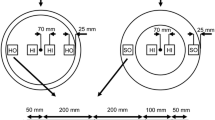Abstract
The potential for using temperature reductions to induce biocide deposition at the end of biocide treatment was assessed using Cyproconazole to treat ponderosa pine sapwood boards. Temperature-induced deposition produced higher biocide loadings and steeper preservative gradients from the surface inward than the more commonly used pressure-induced deposition. The results are discussed in relation to treatment results, process time, and the ability to recover treatment components.





Similar content being viewed by others
References
Acda MN (1995) Supercritical fluid impregnation of wood based composites. PhD dissertation. Oregon State University, Corvallis, 160 pp
Acda MN, Morrell JJ, Levien KL (1997a) Effects of supercritical fluid treatments on physical and mechanical properties of wood-based composites. Wood Fiber Sci 29(2):121–130
Acda MN, Morrell JJ, Levien KL (1997b) Effects of process variables on supercritical fluid impregnation of composites with tebuconazole. Wood Fiber Sci 29(3):282–290
Acda MN, Morrell JJ, Levien KL (2001) Supercritical fluid impregnation of selected wood species with tebuconazole. Wood Sci Technol 35:127–136
American Wood Preserver’s Association (AWPA) (1996) Standard methods for analysis of wood and solutions for propiconazole by HPLC. Standard A23. AWPA Book of Standards, Stevensville, MD, pp 222–224
Anderson ME, Leichti RJ, Morrell JJ (2000) The effect of supercritical CO2 on the bending properties of four refractory wood species. Forest Prod J 50(11/12):85–93
Brantley NH, Bush D, Kazarian SG, Eckert CA (1999) Spectroscopic measurement of solute and cosolvent partitioning between supercritical CO2 and polymers. J Phys Chem B.103:10007–10016
Brogle H (1982) CO2 in solvent extraction. Chem Industry 19:385–390
Cancell F, Bernard C, Demourgues A, Etourneau J, Even C, Garrabos Y, Pessey V, Petit S, Tressaud A, Weill F (1998) Supercritical fluid processing: a new route for materials synthesis. J Mater Chem 9:67–75
Chrastill J (1982) Solubility of solids and liquids in supercritical gases. J Phys Chem 86:3016–3021
Itou NT, Someya T, Taniguchi M, Inamura N (1984) Japanese patent JP 59–101311
Janssen’s product information sheet, n.d. Retrieved May 1, 2002 from http://www.janssenpharmaceutica.be/pmp/Pages/database/Evipol/leaflets/PIS%20Evipol%20technical.pdf
Junsophonsri L (1994) Solubility of biocides in pure and modified supercritical carbon dioxide. MS thesis, Oregon State University, Corvallis, 131 pp
Kayihan F (1992) Method of perfusing a porous workpiece with a chemical composition using cosolvents. US patent US 5,094,892
Kim GH, Morrell JJ (2000) In-situ measurement of dimensional changes during supercritical fluid impregnation of white spruce lumber. Wood Fiber Sci 32(1):29–36
Krukonis VJ (1988) Processing with supercritical fluids: overview and applications. ACS Symposium Series 366:27–43
Matson DW, Fulton JL, Peterson RL (1987) Rapid expansion of supercritical fluid solution: solute formation of powders, thin films, and fibers. Ind Eng Chem Res 26:2298–2306
Matson DW, Norton KA, Smith RD (1989) Making powder and film from supercritical fluid solutions. Chemtech 19:480–486
Mohammed RS, Halverson DS, Debenedetti P, Prud’homme RK (1989) Solid formation after the expansion of supercritical mixture. ACS Symposium Series 406:357
Morrell JJ, Levien KL, Sahle-Demessie E, Kumar S, Smith S, Barnes HM (1993) Treatment of wood using supercritical fluid process. Proc of 14th Annual Meeting of Canad Wood Preservation Assoc, Vancouver, pp 6–35
Muin M, Adachi A, Tsunoda K (2001) Applicability of supercritical carbon dioxide to the preservative treatment of wood-based composites. Int Res Group on Wood Pres Doc No IRG/WP/01–40199. Stockholm, 5 pp
Petersen RD, Matson DW, Smith RD (1987) The formulation of polymer fibers from the rapid expansion of supercritical fluid solutions. US patent US 27:2967
Sahle-Demessie E (1994) Deposition of chemicals in semi-porous solids using supercritical fluid carriers. PhD dissertation, Oregon State University, Corvallis, 301 pp
Smith RD, Fulton JL, Peterson RC, Koprivia AJ, Wright BW (1986) Performance of capillary restrictors in supercritical fluid chromatography. Anal Chem 58:2957
Ward DT (1989) Supercritical fluid-aided deposition of methyl methacrylate into wood. MS Thesis, Univ of Southern Florida, Tampa, 102 pp
Winandy JE, Morrell JJ (1998) Effect of incising on lumber strength and stiffness; relationships between incision density and depth; species and MSR grade. Wood and Fiber Sci 30 (2):185–197
Author information
Authors and Affiliations
Corresponding author
Rights and permissions
About this article
Cite this article
Kang, SM., Levien, K.L. & Morrell, J.J. Supercritical fluid impregnation of wood with biocides using temperature reduction to induce deposition. Wood Sci Technol 39, 328–338 (2005). https://doi.org/10.1007/s00226-005-0295-3
Received:
Published:
Issue Date:
DOI: https://doi.org/10.1007/s00226-005-0295-3




